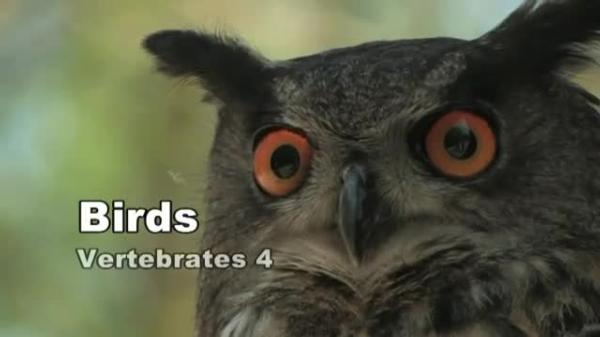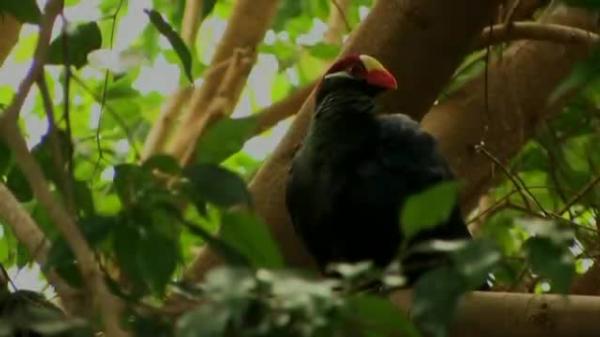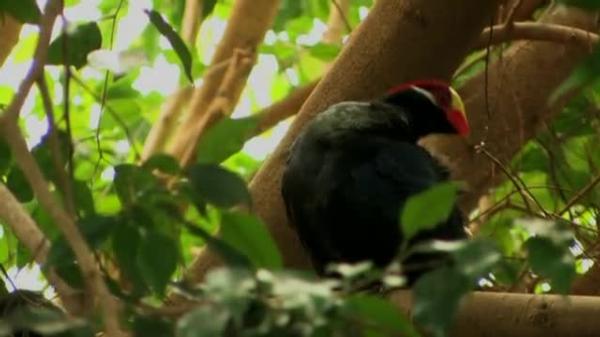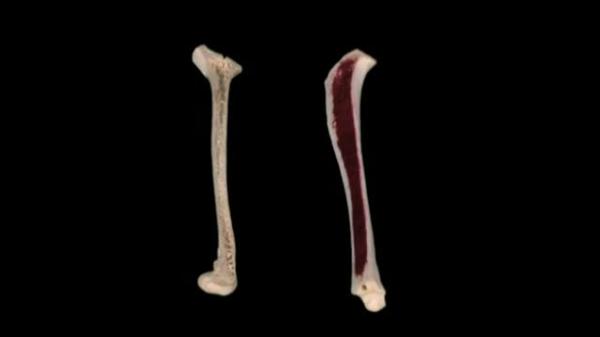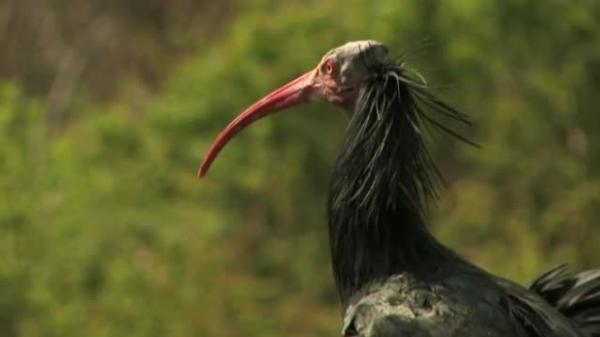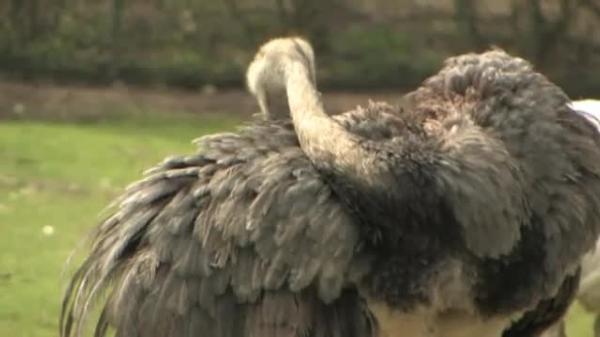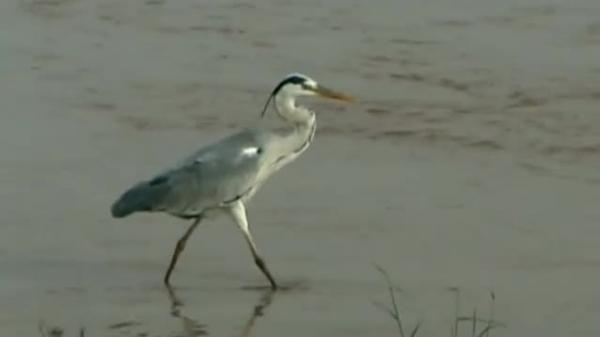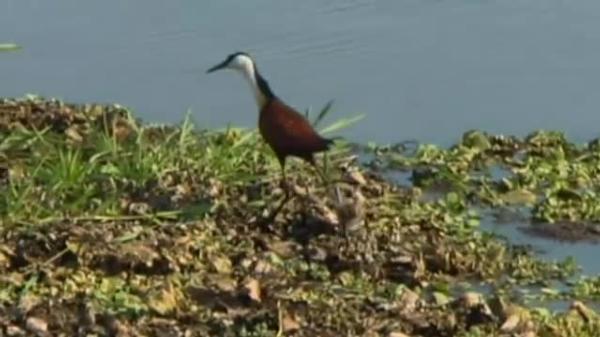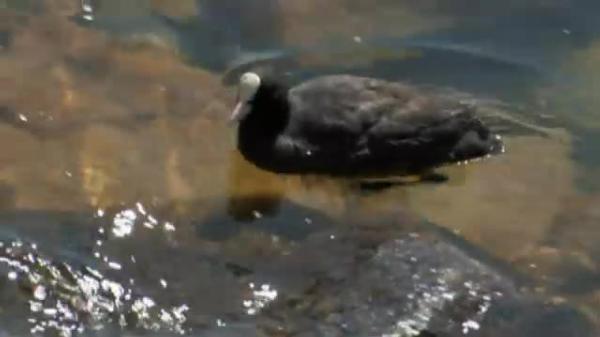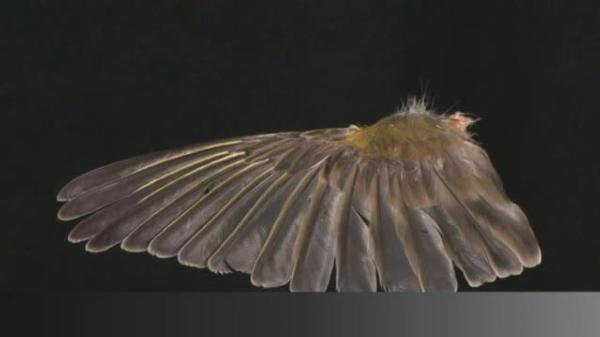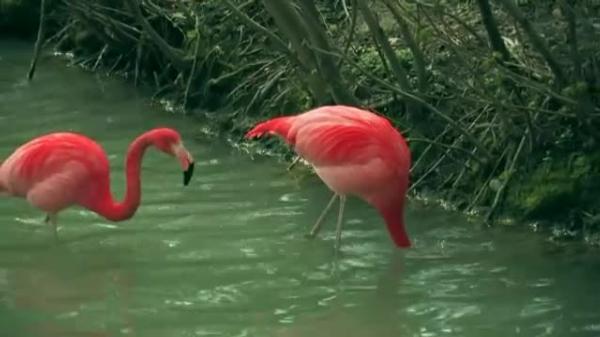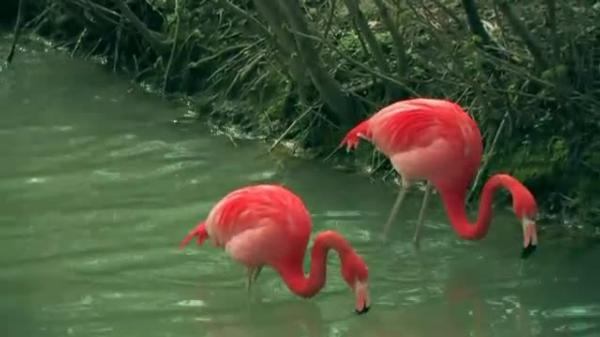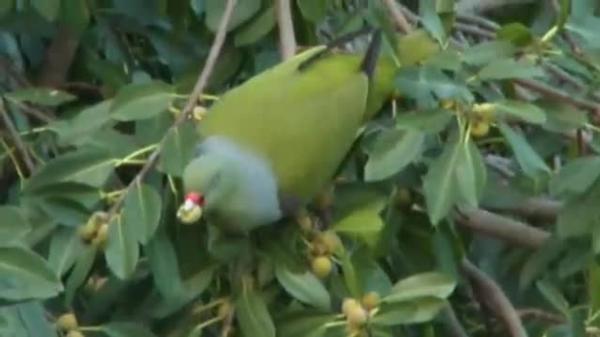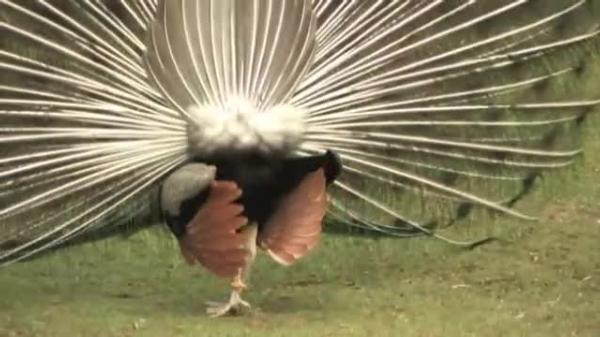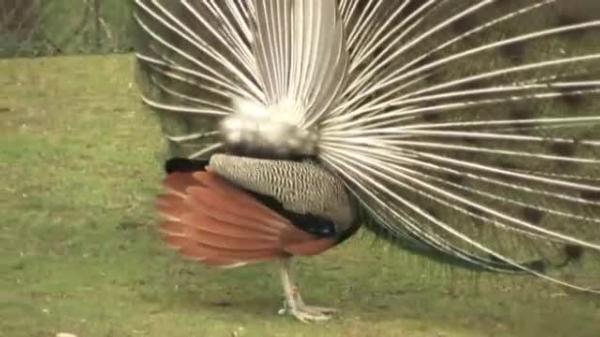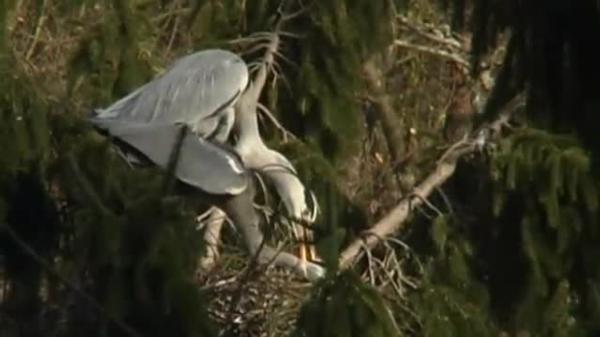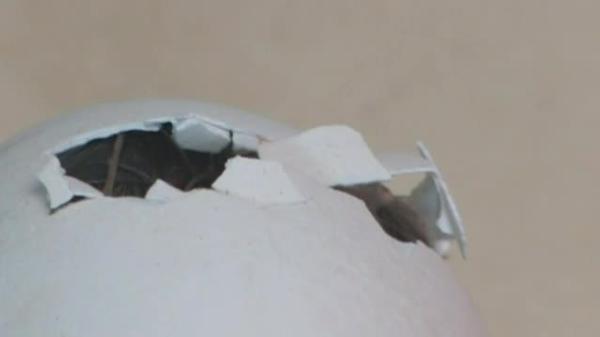Vögel
Wirbeltiere 4

Birds

1. Characteristics 1.1 General Characteristics The world of birds is full of variety. Birds look very different. They vary in size, form, colour, plumage and so on. The shape of a bird's body is the result of its adaptation to environment and food. The Rhea lives in the vast steppes of South America and belongs to the cursorial birds like the ostrich. That's why it has got long, strong legs, but is unable to fly. All birds have beaks. And all birds have feathers, no matter whether they can fly or not, like for example the penguin. 1.2 Body Structure In a human being the share of the bone skeleton amounts to about 15 % of the total body weight. With a bird it is considerably lighter, about 4.4 % in a pigeon, for bird bones are mostly hollow. The cut-open bone of a bird to the left is filled with air, whereas the bone of a mammal to the right is filled with marrow. If we look at the beak and skull of a pelican closely, we realize clearly the porous structure of its bone material. The total weight of the beak and the skull bone of the pelican is only 25 grams. Contrary to the solid and heavy skulls of mammals the bird skull- bone is relatively thin, but nevertheless quite robust. Looked at even more closely, the hollow, air-filled parts can be recognized. A striking characteristic of swans is the long, thin neck. In contrast, sparrows have a very short neck. And with the eagle owl it is no longer recognizable from the outside. All birds, however, have an extremely mobile neck, for their trunk is rigid. Mobile lumbar vertebrae, such as mammals possess, are lacking. 1.3 Shapes of Beaks The form of the beak differs from species to species. The bald eagle shows the typical, strong beak of a predatory bird. All ibis birds have a long downward curved beak like the waldrapp. The beautifully coloured beak of the flamingo is quite conspicuous. Ducks can be recognized by their large, flattened-out beaks. The curved bill characterizes the parrot. A pigeon's beak, however, is inconspicuous. The skeleton of a chicken reveals that the upper beak has grown into one with the skull. The nostrils can be seen clearly. 1.4 Plumage Just like beaks, feathers are a common characteristic of all birds. Size, shape and colour as well as their purpose vary, however. The plumage helps to protect the body against heat loss, for birds, just like mammals, are warm-blooded. The feathers of this rhea, for example, are useless for flying. The feathers are long and broad, but their quill is pliable and has no unbroken vane. If you look at them closely, you recognize the feather barbs growing sideways from the feather shaft. On these barbs there are barbules pointing upwards and downwards. But they are not connected with each other, just like the barbs of this peacock feather. Such feathers are useless for flying. With the proverbially vain peacock the feathers are just decoration and ornament. These wonderfully coloured feathers grow only in the mating season. In summer they are shed and start growing again in the following winter. The crowned crane, however, wears its striking, beautiful head ornament throughout the year. And it's an ornament for both sexes. These eagle feathers, grown into a surface, are used for flying. The minute feathers of the penguin are hardly recognizable as such. Though the bird shows us its wings, it can't fly with them. But they enable the bird to survive in the Antarctic climate with temperatures of minus 60 °C. This small feather belonged to a king penguin. Up to 13 of them can grow on one square centimetre of its skin. The air between the feathers is insulating, so that no body-heat is lost in the cold polar air. Down feathers like these from a duck are light and keep warm as well. That's why we use these feathers as fillings, for example in a down jacket. Feathers can be recognized by their characteristic shape. So even the flight feathers of a wing can be clearly differentiated as hand or arm wings. Hand wings have a narrow outside vane and a wide inside vane. The upper layer of feathers and the tail feathers have a symmetrical vane, that means they are equally wide on both sides of the quill. Feathers for flying like this steering feather and flight feather form an unbroken vane. The vane of the flight feather is asymmetrical, the narrow side is towards the front. If you spread the feather barbs carefully with two fingers, you can see how tightly but supply the barbs are kept together by the connecting hooks. If you pull more strongly, the connection is torn in this place. Similarly to a zip a gap now opens towards the feather shaft. Feathers are used in various ways in a bird's life, so the care of the plumage takes up a lot of time. The shedding and regrowing of feathers is called moult. This penguin exchanges its youth plumage for its first winter plumage when it is fully grown. Penguins, for example, lose up to 50% of their weight while moulting. 2. Birds' Locomotion 2.1 Ashore This elegant glider, the marabou, actually mostly strides ahead. Also this long-legged bird, the heron, belongs to the ciconii formis. With its toes of more than 10-centimetre length this moorhen with a chick in tow can walk comfortably over the leaves on the water surface. The structure of foot and leg is similar to that of the other vertebrates. The foot consists of toes, metatarsal and heel. Above the ankle joint the lower leg starts, just like in humans. Most birds have four toes. The rhea has got only three. Its foot, covered by horn scales, reminds us slightly of the foot of a tyrannosaurus rex. That's no accident, for birds are descendants of reptiles. The knee joint and the thigh are hidden under the bird's plumage as long as the bird is alive. Here is the knee joint. The thigh is nearly horizontal to the pelvic girdle. This coot shows four toes with widenings like folds of skin, which are useful for swimming and prevent the bird from sinking into the mud. 2.2 In Water Ducks belong to the all-rounders as far as their locomotion is concerned. They can fly, walk and swim. Waterbirds like this greylag goose have webbed toes. This duck has distinctive webs, too. Coots can also dive. As they propel themselves with their feet, they belong to the foot divers. Diving ducks, however, like this heron duck, are wing divers. Cormorants also live on the water and are even better divers than ducks and coots. This golden eye duck can even dive several metres deep to look for insect larvae under the stones. The brilliantly coloured drake of the golden eye can be recognized by the round white spot on its face. Penguins have adapted perfectly to the water. Depending on the species, they dive hundreds of metres while still catching fish, for they swim at a speed of 60 kilometres per hour. After every dive or swim the plumage must be preened carefully. With the beak the grease from the rump gland is spread all over the feathers. It forms a smooth, water-repellent protective coating. The biggest bird living in our area is the white swan. Here it shows us its impressive, spread-out wings, which reach a span of almost three metres. The swan has acute problems taking off. With its weight of 22 kilos it is in danger of becoming flightless. At 23 kilos it wouldn't be able to fly any longer. Weight is the most important criterion for flying. A bird must be light to be able to fly well. 2.3 In the Air Besides a light body, wings are of course essential for flying. As various as the bird species themselves are their flight mechanisms. Their wings, and in addition their feathers, indispensable for flying, developed from their front extremities and their arm, hand and finger bones. Compared with the human skeleton, forearm and upper arm bones still show strong similarities. The bird's carpal, metacarpal and finger bones, however, are very much reduced. Birds have only one finger. To keep its wings spread out and to be able to fold them again the bird needs about ten more muscles. The wings of the penguin, though, only help it to fly under water, which needs more strength than flying through the air. The wing span of the marabou is more than three metres from one wing tip to the other. Body weight, wings and feathers are important requirements for flying like these winged fellows, the bateleur and the marabou. Not only the take-off but also the landing is of extreme importance, just as they are for airplanes. 3. Food 3.1 Species Appropriate Diet The form of the beak reveals a lot about a bird's diet. The long curved beaks of the ibises are well suited to poke for worms and insect larvae in the muddy ground with them. Flamingoes filter the water for brine shrimps, whose red pigment, carotene, they store in their plumage. With a speed of over 300 kilometres per hour during a nosedive, the peregrine falcon is quite the fastest animal among the vertebrates. With the so-called falcon tooth it effortlessly severs the cervical vertebrae of a mouse. The form of its nostrils makes breathing possible even in a steep dive. The prey caught by this buzzard is swallowed immediately on the ground. The big rhea is mainly satisfied with grass. Swans search for their food in the water, that is they dive for insect larvae on the ground among stones or in the mud. The peacock belongs to the gallinaceous birds. It feeds on grain and picks its food from the ground. 3.2 The Beak as a Tool With its strong pointed beak the heron spears a fish as with a harpoon. This Sunbird reaches down to the bottom of the blossoms to get at the sweet nectar. The African green pigeon loves unripe figs or other small fruit suitable for its small beak. The beak of the hornbill bird is an impressive weapon. If a snake falls prey to it, the bird effortlessly crushes its head to offer the carcass to a chick which swallows it in a jiffy. The beak of the pied kingfisher is longer than its head and helps it to spear small fish as the heron does. Like the pied kingfisher the woodland kingfisher as well as the malachite belong to the kingfishers. Kingfishers lurk for their prey at the water's edge and then pounce on it as fast as lightning. The wood ibis uses its spearhead beak to catch amphibians and fish. Once the keen eye of the egret has spotted a fish it rarely escapes its long pointed beak. The night heron, indigenous to Africa, is an equally successful catcher of fish. Here it even caught two fish at once. The secretary bird, which belongs to the birds of prey, is out in the steppe hunting for snakes, young birds, eggs and insects. Of course the beak also serves for drinking. The hawfinch even succeeds in crushing cherry stones to get at the soft core. This young moorhen has found a dead fish, which is now eaten by the whole family together. Carrion eaters are no rarity among birds. 4. Reproduction 4.1 Mating The blue peacock, which originates from Africa and is one of the biggest gallinaceans, is worshipped as the symbol of the god Krishna in India. This worship is due not only to its beauty but also to the fact that it feeds on young cobras and warns about tigers and leopards with its call. In our area it is only known because of its fanned-out tail. In order to impress the female the peacock spreads its extremely long and magnificently coloured tail feathers into a fan. This display pattern used in looking for a mate is called courtship. The piercing cry uttered before and during the mating dance can be heard from afar and is meant to attract a peahen. After the mating season the peacocks shed their long tail feathers, which won't regrow until the next spring. Until the Middle Ages waldrapps were indigenous round here, but are meanwhile threatened with extinction. Courtship rituals are always meant for finding a mate and are different for each species. The movements of this couple, executed in unison, serve to strengthen their bond. The pursuit of a female is not always undisturbed. If two males court the same female the first concern is to get rid of the annoying rival. As soon as the two hammer headed storks, natives of Africa, have found each other at last, it is necessary to build a nest. 4.2 Nest Building and Breeding In the broken treetop of a spruce this grey heron couple have found a safe and undisturbed place for their nest. The male fetches twigs to reinforce it. Before the female lays its eggs into the nest they must be fertilized. The male climbs on the back of the female, which can be a real balancing act for the long-legged herons. The cormorants, too, breed in trees, build large nests and make sure through frequent copulation that no unfertilized eggs are laid. The hammerhead and its female have built a big nest at a dizzy height, too, with a small entrance opening in its lower part. Not all birds hide their nests in remote places. In this tree there is an abundance of small spherical nests. They belong to the African weavers, which nest in colonies, seeking the protection of the group and often build their nests at a few centimetres' distance only. The weavers were given their name because of their elaborately built nests. Fresh blades of grass are very cleverly intertwined, following the pattern of warp and waft, and fixed to a branch. The inside padding of the nests is done exclusively by the females. Bee-eaters are among the most colorful birds in the world and as their name indicates preferably feed on wasps, bees , hornets and bumble-bees, which they catch in mid-air. They are companionable birds. They mostly nest in large colonies. They dig one to two-metre-deep nesting tubes in the sand or earthwalls of steep banks. So they are cave-nesting. Our native greylag goose prefers her nest on the ground. Already before brooding geese and ducks sprout the warm nest-down on their body undersides. This one is busy plucking some of it to pad its nest with. When leaving the nest, it also covers the eggs with it. Now and again the breeding bird gets up in order to turn the eggs. Through this process the centre of gravity is to move downwards and the embryo and the developing bird upwards. Even throughout breeding there is always something to mend on the nest. This moorhen has found a branch it wants to integrate into the nest. Although it is somewhat unwieldy, the bird succeeds in handing it over to the partner in the nest. Well camouflaged is the nest of this moorhen in immediate vicinity to the water. The breeding times are very different. 4.3 Hatching of the Chicks This chicken egg has been hatched for 21 days and now the chick is laboriously working its way out of the egg shell for hours. After opening the air pocket in the egg it can breathe and even peeps while still inside the shell. Now the shell is cut through in a circle with the egg tooth until it can be opened. At last the chick can leave the egg and tries to stand up. After a few hours the feathers are dry and the chick is ready. On the tip of its beak we can still see the yellowish egg tooth, which will drop off after three days as it was only needed for opening the shell. Gallinaceous birds leave the nest early. Already at birth they have feathers and their eyes are open. These chicks, which are only a few days old, grow up without their mother, protected by the coop. They can already walk, scratch, eat and drink. The chick of the moorhen leaves the nest early, too, and can even - although somewhat hesitantly - follow its mother into the water and swim. There it learns what is suitable for feeding. A mother duck needn't teach her ducklings how to swim. They follow their mother through thick and thin. Ducks like to nest in lofty tree holes, the ducklings then jump down several metres to the ground unharmed. Meanwhile the grey herons have hatched out. However, flying is still a remote possibility. Although they have soon reached their parents' size, the latter must still provide their food. For to be able to get their own food, they must leave the nest and this is only possible when they are fully fledged. They must learn to fly just as an infant learns to walk. The first efforts aren't successful straight away, but at last it is done without the parents' help. Once the nest is left, the serious part of life starts for the bird. It must look for and find food, a territory must be conquered and defended, enemies must be avoided and after sexual maturity a mate must be found to secure a continued existence in the next generation.

